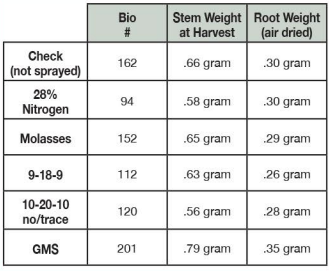Foliar Feeding Results
Since GMS was developed, hundreds of test plots were done showing yield and quality advantages of properly foliar feeding various amounts of GMS. But I always wondered: what was the mechanism of gain? Why were the results so variable?
Some of the issues were because of the source water used, and water tests were developed to help farmers with that issue. But how could we show what the plant did with GMS when applied through the leaves?
After much trial, error, and equipment development, a protocol was developed that would reveal the effect of foliar feeding various materials and how the plants utilized them for quality and yield gain.
Vials of soil with equal weight and same one-time watering of pure water were established and foliage fed with the equivalent of 2 gallons/acre of GMS in 15 gallons of pure water. Other materials included in the test were a 10-20-10 with no/trace elements; 28% nitrogen; molasses (blackstrap); and a 9-18-9.
The plants were grown and collected for sampling once they started to wilt to facilitate ease of harvesting the roots and soil testing with the biometer (the biometer is a comparison test producing a number representing the bio-mass of fungi and bacteria).
A study of the results gave insight into the 3 mechanisms the plants utilize for GMS and the resulting yield/quality gain. To what extent plants can fully manifest the potential of these gains has much to do with soil environment, weather, and a farmer who is observant in seeing plant stresses through the season.
This is an excerpt from the Late Fall Growers Solution (2022) written by Matthew Gooding.
Signup for our newsletter to stay in the loop
The above ground plant parts and the soil sample cups, along with the roots before drying, are shown above. L-R: Check (unsprayed); 28% N; Molasses; 9-18-9; 1-20-10 no/trace elements; and Growers Mineral Solutions.



